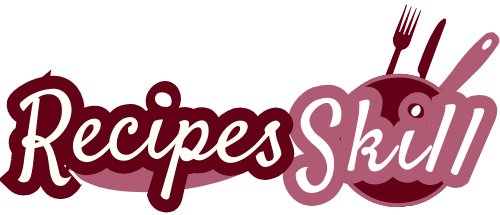Cooking salmon can be a delightful experience, but it often raises the question: How long should salmon be cooked in the oven? This article will guide you through the ins and outs of oven-baked salmon, from preparation to serving suggestions. Whether you’re a novice in the kitchen or a seasoned chef, understanding the nuances of cooking salmon will help you achieve that perfect flaky texture and rich flavor. So, let’s dive into the world of salmon cooking!
Cooking salmon can be a delightful experience, offering a range of flavors and health benefits. Whether you’re a novice or an experienced chef, mastering the art of baking salmon is essential. For a simple yet delicious recipe, check out this baked salmon recipe that will impress your family and friends. This dish not only highlights the natural flavors of the fish but also provides a nutritious meal option that is quick to prepare.
Introduction
Importance of Cooking Salmon Properly
When it comes to cooking salmon, getting it just right is crucial. Overcooked salmon can turn dry and unappetizing, while undercooked salmon can pose health risks. Therefore, knowing the right cooking time and temperature is essential for both flavor and safety.
Overview of Cooking Methods
While there are various methods to cook salmon—grilling, poaching, and pan-searing—oven baking is one of the most popular. It allows for even cooking and can easily accommodate different flavors and seasonings. Plus, it’s a hands-off approach that lets you focus on preparing side dishes or enjoying a glass of iced tea while your salmon cooks.
How long should salmon be cooked in the oven?
In this article, we’ll explore the best practices for cooking salmon in the oven, including the ideal cooking times based on thickness, tips for enhancing flavor, and how to check for doneness. By the end, you’ll be well-equipped to serve up a delicious salmon dish that will impress your family and friends. So, let’s get started!
Understanding Salmon
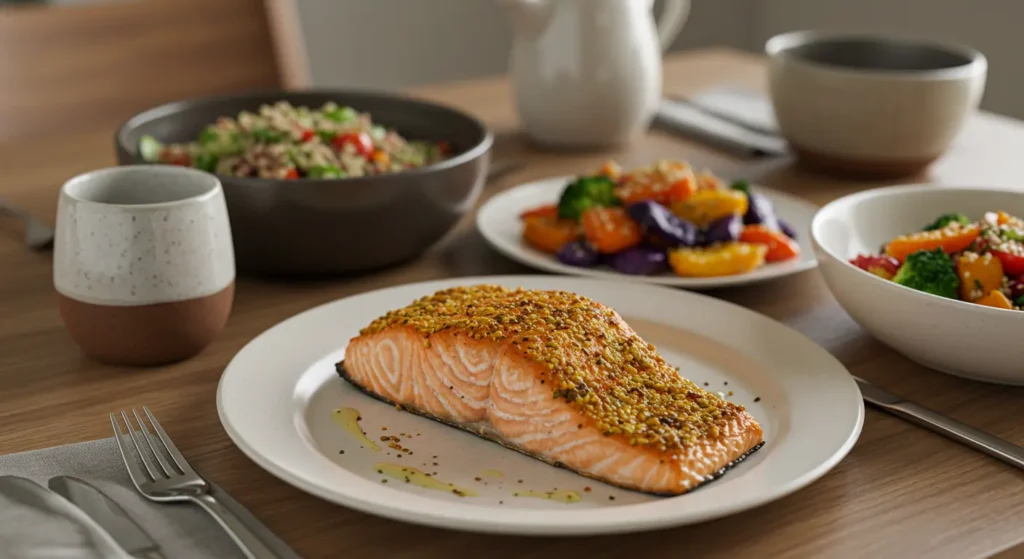
Types of Salmon
When it comes to cooking salmon, it’s essential to know the different types available. Each type has its unique flavor profile and texture, which can influence how you cook it.
1. Atlantic Salmon
Atlantic salmon is the most commonly found type in grocery stores. It’s known for its rich, buttery flavor and high-fat content, making it incredibly moist when cooked. This type is often farmed, which means it’s available year-round.
2. Pacific Salmon
Pacific salmon includes several species, such as sockeye, coho, and king salmon. Each has its distinct taste and texture. For instance, sockeye salmon is known for its deep red color and robust flavor, while king salmon is prized for its high oil content and tenderness. Understanding these differences can help you choose the right salmon for your dish.
Nutritional Benefits of Salmon
Salmon is more than just a tasty addition to your plate; it’s a nutritional powerhouse. Loaded with omega-3 fatty acids, it supports heart health and reduces inflammation. This nutrient-dense fish is also an excellent source of high-quality protein, essential vitamins like B12 and D, and minerals such as selenium and potassium. Incorporating salmon into your diet can enhance overall wellness, promote brain function, and even improve skin health. Explore the remarkable benefits of salmon in this detailed guide on Salmon Nutrition and Health Benefits.
Why Oven Cooking is Popular
Oven cooking is a favored method for preparing salmon for several reasons. First, it allows for even heat distribution, ensuring that the fish cooks uniformly. Second, it’s a versatile method that accommodates various seasonings and marinades. Lastly, baking salmon in the oven is relatively simple and requires minimal hands-on time, making it perfect for busy weeknights or special occasions.
Preparing Salmon for Cooking
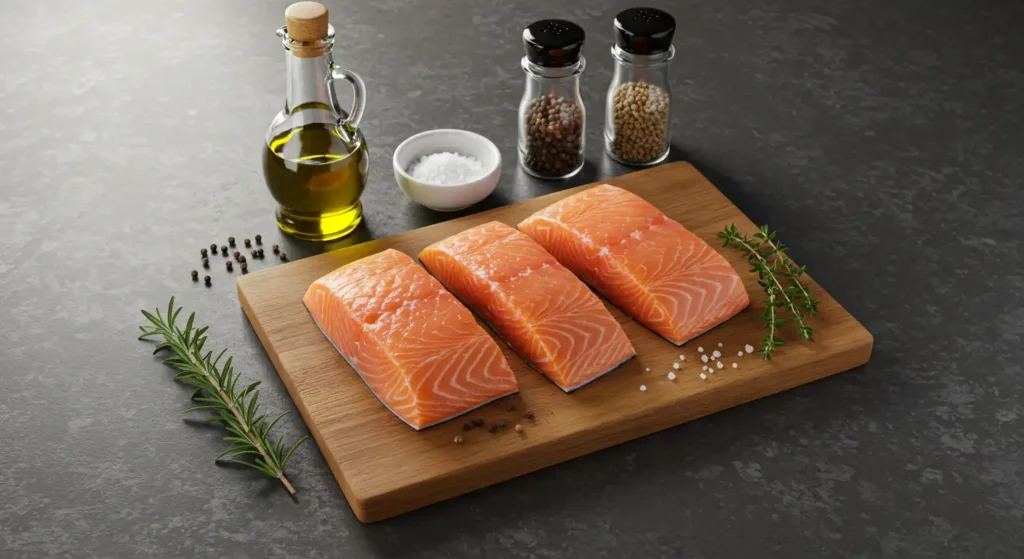
1. Selecting Fresh Salmon
The first step in preparing salmon is selecting the freshest fish possible. When shopping, look for salmon that has a bright, vibrant color and a moist appearance. The flesh should be firm to the touch, and there shouldn’t be any off-putting odors. If you’re buying from a fish market, don’t hesitate to ask the fishmonger about the catch of the day. Freshness is key to achieving that delectable flavor and texture.
2. Thawing Frozen Salmon
If you’ve opted for frozen salmon, proper thawing is crucial. The best way to thaw salmon is to place it in the refrigerator overnight. This slow thawing method helps maintain the fish’s texture and flavor. If you’re short on time, you can also submerge the sealed salmon in cold water for about an hour. Avoid using hot water or microwaving, as these methods can lead to uneven thawing and affect the quality of the fish.
3. Marinating and Seasoning
Once your salmon is thawed and ready, it’s time to enhance its flavor. Marinating salmon can add depth and richness to the dish. A simple marinade can include olive oil, lemon juice, garlic, and your choice of herbs. Allow the salmon to marinate for at least 30 minutes, but no longer than two hours, to avoid the fish becoming mushy. If you prefer a dry seasoning, a sprinkle of salt, pepper, and your favorite spices can work wonders too!
4. Preparing the Oven and Baking Dish
Before you pop that salmon in the oven, preheat it to the desired temperature typically around 375°F (190°C) for baking. While the oven heats up, prepare your baking dish. You can line it with parchment paper or aluminum foil for easy cleanup. If you’re feeling adventurous, consider adding sliced vegetables or lemon wedges to the dish for added flavor and presentation.
Cooking Salmon in the Oven
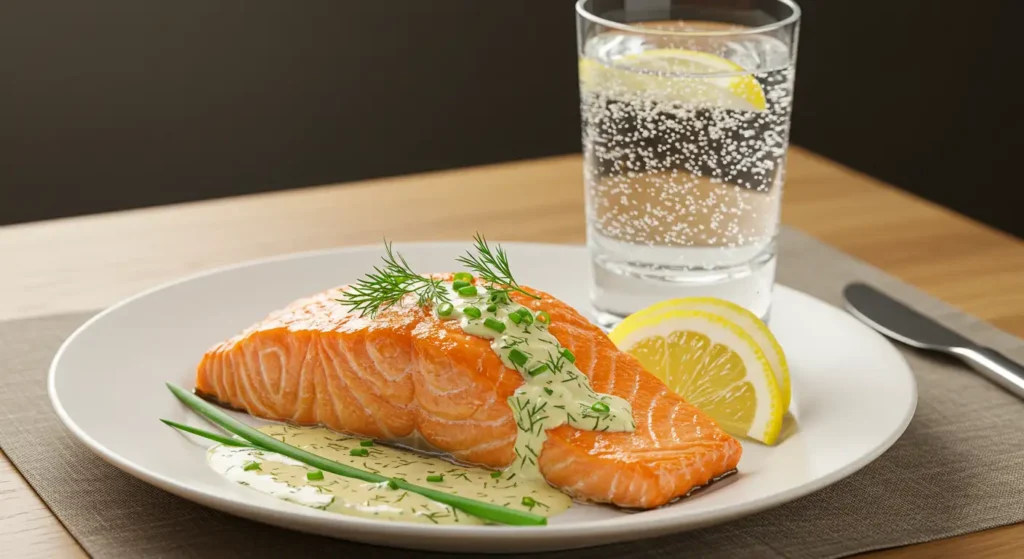
Recommended Cooking Temperatures
When it comes to cooking salmon in the oven, temperature plays a crucial role in achieving that perfect texture.
Standard Oven Temperature
For most recipes, a standard oven temperature of 375°F (190°C) is ideal for baking salmon. This temperature allows the fish to cook evenly without drying out. If you prefer a slightly crispier exterior, you can increase the temperature to 400°F (200°C), but keep a close eye on the cooking time to avoid overcooking.
Broiling vs. Baking
Another option is broiling, which cooks the salmon from above. Broiling is great for achieving a caramelized crust while keeping the inside moist. If you choose to broil, set your oven to the broil setting and place the salmon on the top rack. Cooking times will be shorter, typically around 6 to 10 minutes, depending on the thickness of the fillet.
Cooking Times Based on Thickness
The thickness of your salmon fillet significantly affects the cooking time.
General Rule of Thumb
A good rule of thumb is to cook salmon for about 4 to 6 minutes per half-inch of thickness. For example, if your salmon fillet is 1 inch thick, you should aim for a cooking time of approximately 8 to 12 minutes.
Cooking Time for Different Cuts
Different cuts of salmon may require varying cooking times. Here’s a quick guide:
- Salmon fillets: 12 to 15 minutes at 375°F (190°C)
- Salmon steaks: 15 to 20 minutes at 375°F (190°C)
- Whole salmon: 20 minutes per pound at 375°F (190°C)
Always remember that these times are approximate, so it’s essential to check for doneness as you cook.
Checking for Doneness
Knowing when your salmon is perfectly cooked is key to enjoying a delicious meal.
Internal Temperature Guidelines
The USDA recommends that salmon be cooked to an internal temperature of 145°F (63°C). You can use a meat thermometer to check the thickest part of the fillet. Once it reaches this temperature, the salmon should be opaque and flake easily with a fork.
Visual Cues for Doneness
If you don’t have a thermometer handy, there are visual cues to look for. The salmon should change from a translucent pink to an opaque color. Additionally, the flesh should easily flake apart when gently pressed with a fork. If it’s still translucent or resists flaking, it likely needs more time in the oven.
Tips for Perfectly Cooked Salmon
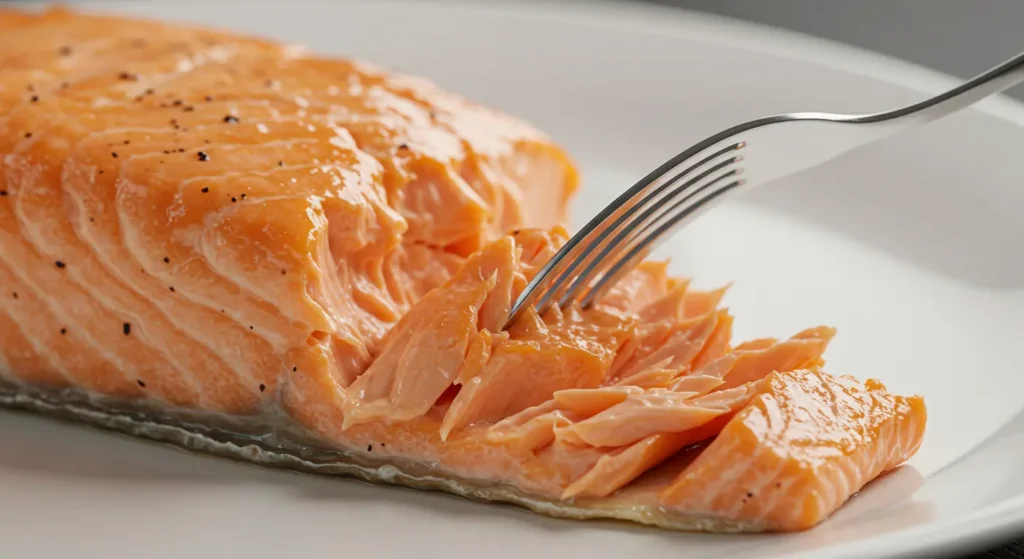
1. Avoiding Common Mistakes
Cooking salmon may seem straightforward, but there are a few common pitfalls to avoid. One of the biggest mistakes is overcooking the fish. Salmon can go from perfectly flaky to dry in a matter of minutes, so keep a close eye on it as it cooks. Another mistake is not letting the salmon rest after cooking. Allowing it to sit for a few minutes before serving helps the juices redistribute, resulting in a more flavorful dish.
2. Enhancing Flavor with Herbs and Spices
To elevate your salmon dish, consider experimenting with various herbs and spices. Fresh herbs like dill, parsley, or cilantro can add a burst of flavor. You can also try spices like paprika, cumin, or even a touch of cayenne for some heat. A squeeze of fresh lemon juice right before serving can brighten the flavors and make your salmon shine.
3. Using Foil or Parchment Paper
For an easy cleanup and to lock in moisture, consider cooking your salmon in foil or parchment paper. This method, often referred to as “en papillote,” allows the salmon to steam in its own juices, resulting in a tender and flavorful dish. Simply place the seasoned salmon on a piece of foil or parchment, fold it into a packet, and bake. This technique is not only convenient but also adds a unique presentation when serving.
4. Resting Time After Cooking
After removing your salmon from the oven, resist the urge to dive right in. Letting it rest for about 5 minutes allows the residual heat to finish cooking the fish and helps retain its moisture. This simple step can make a significant difference in the overall texture and flavor of your dish.
Serving Suggestions
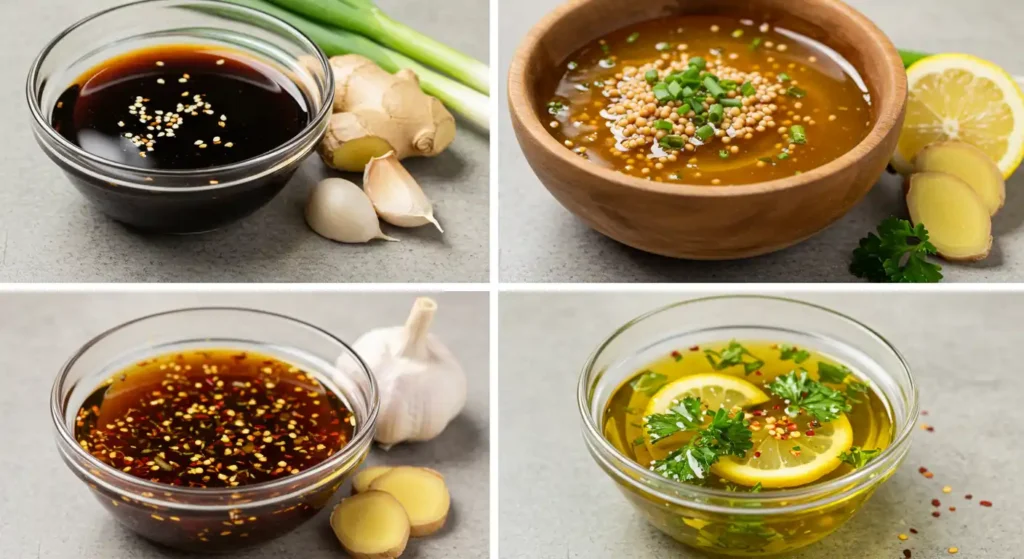
. Side Dishes that Pair Well with Salmon
When it comes to serving salmon, the right side dishes can elevate your meal to new heights. Here are some fantastic options that complement the rich flavor of salmon:
- Roasted Vegetables: Seasonal vegetables like asparagus, Brussels sprouts, or carrots roasted with olive oil and herbs make a colorful and nutritious side.
- Quinoa or Rice: A light and fluffy grain like quinoa or a fragrant rice pilaf can balance the richness of the salmon. Consider adding herbs or nuts for extra flavor.
- Salads: A fresh salad with mixed greens, cherry tomatoes, and a light vinaigrette can provide a refreshing contrast to the warm salmon. You might also try a citrus salad with oranges or grapefruits for a zesty twist.
2. Sauces and Condiments
Adding a sauce or condiment can take your salmon dish to the next level. Here are some delicious options to consider:
- Lemon-Dill Sauce: A simple sauce made with Greek yogurt, fresh dill, and lemon juice can add a creamy, tangy element that pairs beautifully with salmon.
- Honey-Mustard Glaze: A mixture of honey, Dijon mustard, and a splash of soy sauce creates a sweet and savory glaze that caramelizes beautifully when baked.
- Chimichurri: This vibrant sauce made from parsley, garlic, vinegar, and olive oil adds a fresh, herby kick that complements the richness of the fish.
3. Presentation Tips
Presentation is key when serving salmon, especially if you’re entertaining guests. Here are some tips to make your dish visually appealing:
- Garnish: Fresh herbs, lemon wedges, or edible flowers can add a pop of color and freshness to your plate.
- Plating: Consider using a large platter to serve the salmon family-style, or plate individual portions with a side of vegetables and a drizzle of sauce for a more refined look.
- Color Contrast: Aim for a variety of colors on the plate. The vibrant pink of the salmon, combined with the greens of vegetables and the yellows of grains, creates an inviting and appetizing presentation.
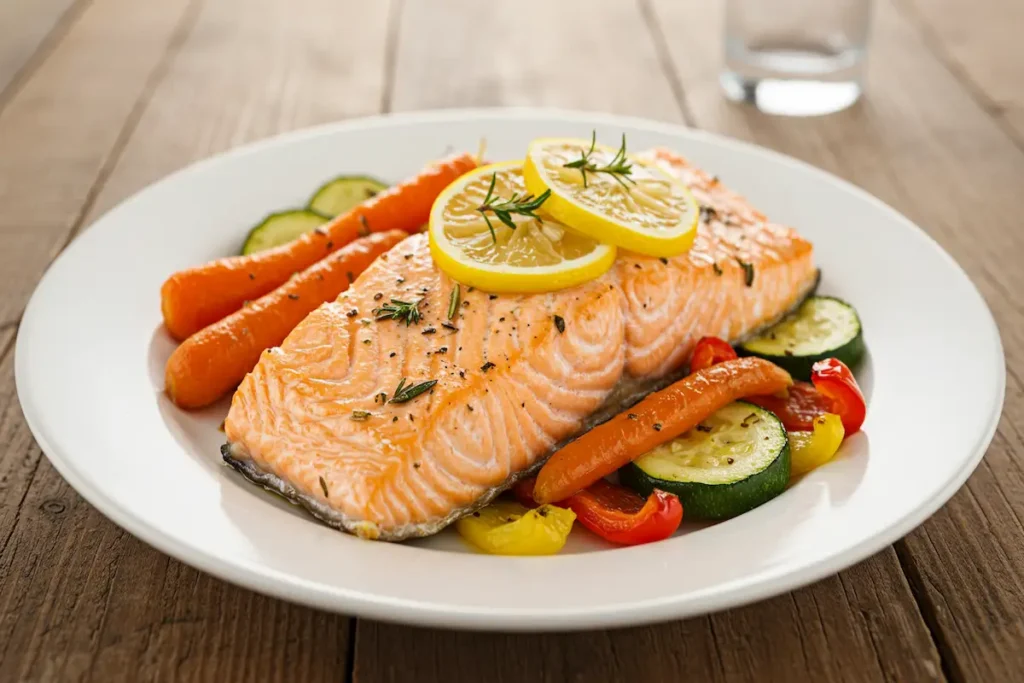
FAQs
1. How long should salmon be cooked at 350°F?
If you’re cooking salmon at 350°F (175°C), the general rule of thumb is to cook it for about 15 to 20 minutes, depending on the thickness of the fillet. For a standard 1-inch thick fillet, aim for around 18 minutes. Always check for doneness by ensuring the internal temperature reaches 145°F (63°C).
2. Can you overcook salmon in the oven?
Absolutely! Overcooking salmon is one of the most common mistakes. When salmon is overcooked, it can become dry and lose its delicate flavor. To avoid this, keep a close eye on the cooking time and use a meat thermometer to check for doneness. Remember, it’s better to slightly undercook and let it rest than to overcook.
3. What is the best way to store leftover salmon?
If you have leftover salmon, store it in an airtight container in the refrigerator. It’s best consumed within 2 to 3 days. If you want to keep it longer, consider freezing it. Wrap the salmon tightly in plastic wrap and then place it in a freezer-safe bag. It can last up to 3 months in the freezer. When ready to eat, thaw it in the refrigerator overnight before reheating.
4. Is it safe to eat undercooked salmon?
While some people enjoy their salmon slightly undercooked, it’s essential to be cautious. The USDA recommends cooking salmon to an internal temperature of 145°F (63°C) to ensure it’s safe to eat. If you choose to eat it rare or medium-rare, make sure you’re sourcing high-quality, sushi-grade salmon to minimize health risks.
Conclusion
In this article, we’ve explored the ins and outs of cooking salmon in the oven. From selecting the freshest fish to understanding cooking times and temperatures, you now have the tools to create a delicious salmon dish. Remember to experiment with flavors, avoid common mistakes, and pay attention to doneness for the best results.
Don’t be afraid to get creative in the kitchen! Salmon is a versatile fish that can be paired with a variety of flavors and cooking methods. Whether you’re baking, broiling, or experimenting with different marinades, the possibilities are endless. So, roll up your sleeves, fire up that oven, and enjoy the delightful experience of cooking salmon. Happy cooking!
